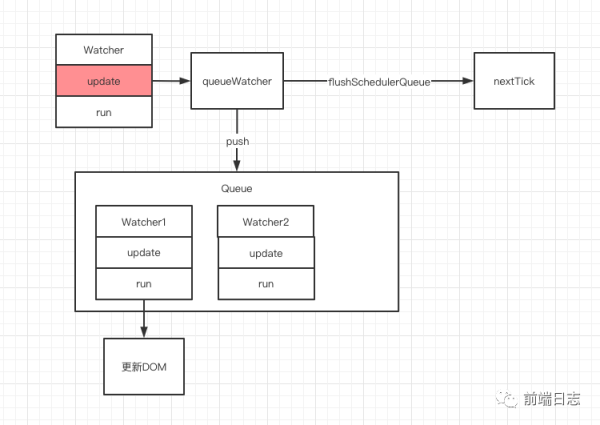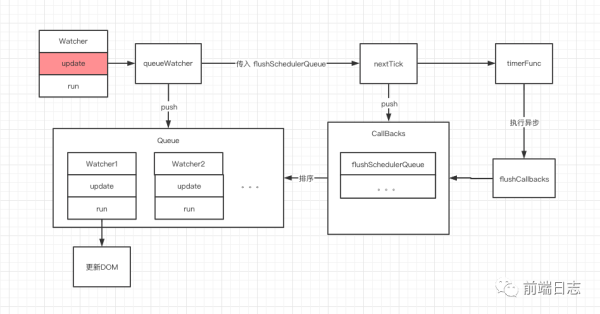图解 Vue 异步更新原理
作者:互联网
本文转载自微信公众号「 前端日志」,作者 前端日志。转载本文请联系 前端日志公众号。
本文主要分析 Vue 从 Data 更新,到通知 Watcher 异步更新视图的流程,也就是下图中的橙色部分。
我们先来回顾一下图中的几个对象:
Data 对象:Vue 中的 data 方法中返回的对象。
Dep 对象:每一个 Data 属性都会创建一个 Dep,用来搜集所有使用到这个 Data 的 Watcher 对象。
Watcher 对象:主要用于渲染 DOM。
接下来,我们就开始分析这个流程。
Vue 异步更新 DOM 原理
很多同学都知道,Vue 中的数据更新是异步的,意味着我们在修改完 Data 之后,并不能立刻获取修改后的 DOM 元素。
例如:
<template>
<div>
<span id="text">{{ message }}</span>
<button @click="changeData">
changeData
</button>
</div>
</template>
<script>
export default {
data() {
return {
message: "hello",
};
},
methods: {
changeData() {
this.message = "hello world";
const textContent = document.getElementById("text").textContent;
// 直接获取,不是最新的
console.log(textContent === "hello world"); // false
// $nextTick 回调中,是最新的
this.$nextTick(() => {
const textContent = document.getElementById("text").textContent;
console.warn(textContent === "hello world"); // true
});
},
},
};
</script>什么时候我们才能获取到真正的 DOM 元素?
答:在 Vue 的 nextTick 回调中。
这一点在 Vue 官网有详细的介绍,但你是否有想过,为什么 Vue 需要通过 nextTick 方法才能获取最新的 DOM?
带着这个疑问,我们直接看一下源码。
// 当一个 Data 更新时,会依次执行以下代码
// 1. 触发 Data.set
// 2. 调用 dep.notify
// 3. Dep 会遍历所有相关的 Watcher 执行 update 方法
class Watcher {
// 4. 执行更新操作
update() {
queueWatcher(this);
}
}
const queue = [];
function queueWatcher(watcher: Watcher) {
// 5. 将当前 Watcher 添加到异步队列
queue.push(watcher);
// 6. 执行异步队列,并传入回调
nextTick(flushSchedulerQueue);
}
// 更新视图的具体方法
function flushSchedulerQueue() {
let watcher, id;
// 排序,先渲染父节点,再渲染子节点
// 这样可以避免不必要的子节点渲染,如:父节点中 v-if 为 false 的子节点,就不用渲染了
queue.sort((a, b) => a.id - b.id);
// 遍历所有 Watcher 进行批量更新。
for (index = 0; index < queue.length; index++) {
watcher = queue[index];
// 更新 DOM
watcher.run();
}
}根据上面的代码,我们可以得出这样一个流程图:
图中可以看到,Vue 在调用 Watcher 更新视图时,并不会直接进行更新,而是把需要更新的 Watcher 加入到 Queue 队列里,然后把具体的更新方法 flushSchedulerQueue 传给 nextTick 进行调用。
接下来,我们分析一下 nextTick。
const callbacks = [];
let timerFunc;
function nextTick(cb?: Function, ctx?: Object) {
let _resolve;
// 1.将传入的 flushSchedulerQueue 方法添加到回调数组
callbacks.push(() => {
cb.call(ctx);
});
// 2.执行异步任务
// 此方法会根据浏览器兼容性,选用不同的异步策略
timerFunc();
}可以看到,nextTick 函数非常简单,它只是将传入的 flushSchedulerQueue 添加到 callbacks 数组中,然后执行了 timerFunc 方法。
接下来,我们分析一下 timerFunc 方法。
let timerFunc;
// 判断是否兼容 Promise
if (typeof Promise !== "undefined") {
timerFunc = () => {
Promise.resolve().then(flushCallbacks);
};
// 判断是否兼容 MutationObserver
// https://developer.mozilla.org/zh-CN/docs/Web/API/MutationObserver
} else if (typeof MutationObserver !== "undefined") {
let counter = 1;
const observer = new MutationObserver(flushCallbacks);
const textNode = document.createTextNode(String(counter));
observer.observe(textNode, {
characterData: true,
});
timerFunc = () => {
counter = (counter + 1) % 2;
textNode.data = String(counter);
};
// 判断是否兼容 setImmediate
// 该方法存在一些 IE 浏览器中
} else if (typeof setImmediate !== "undefined") {
// 这是一个宏任务,但相比 setTimeout 要更好
timerFunc = () => {
setImmediate(flushCallbacks);
};
} else {
// 如果以上方法都不知道,使用 setTimeout 0
timerFunc = () => {
setTimeout(flushCallbacks, 0);
};
}
// 异步执行完后,执行所有的回调方法,也就是执行 flushSchedulerQueue
function flushCallbacks() {
for (let i = 0; i < copies.length; i++) {
callbacks[i]();
}
}可以看到,timerFunc 是根据浏览器兼容性创建的一个异步方法,它执行完成之后,会调用 flushSchedulerQueue 方法进行具体的 DOM 更新。
分析到这里,我们就可以得到一张整体的流程图了。
接下来,我们来完善一些判断逻辑。
判断 has 标识,避免在一个 Queue 中添加相同的 Watcher。
判断 waiting 标识,让所有的 Watcher 都在一个 tick 内进行更新。
判断 flushing 标识,处理 Watcher 渲染时,可能产生的新 Watcher。
如:触发了 v-if 的条件,新增的 Watcher 渲染。
结合以上判断,最终的流程图如下:
最后,我们分析一下,为什么 this.$nextTick 能够获取更新后的 DOM?
// 我们使用 this.$nextTick 其实就是调用 nextTick 方法
Vue.prototype.$nextTick = function (fn: Function) {
return nextTick(fn, this);
};可以看到,调用 this.$nextTick 其实就是调用了图中的 nextTick 方法,在异步队列中执行回调函数。根据先来后到原则,修改 Data 触发的更新异步队列会先得到执行,执行完成后就生成了新的 DOM ,接下来执行 this.$nextTick 的回调函数时,能获取到更新后的 DOM 元素了。
由于 nextTick 只是单纯通过 Promise 、SetTimeout 等方法模拟的异步任务,所以也可以手动执行一个异步任务,来实现和 this.$nextTick 相同的效果。
this.message = "hello world";
// 手动执行一个异步任务,也能获取最新的 DOM
Promise.resolve().then(() => {
const textContent = document.getElementById("text").textContent;
console.log(textContent === "hello world"); // true
});
setTimeout(() => {
const textContent = document.getElementById("text").textContent;
console.log(textContent === "hello world"); // true
});思考与总结
本文从源码的角度,介绍了 Vue 异步更新的原理,来简单回顾一下吧。
修改 Vue 中的 Data 时,就会触发所有和这个 Data 相关的 Watcher 进行更新。
首先,会将所有的 Watcher 加入队列 Queue。
然后,调用 nextTick 方法,执行异步任务。
在异步任务的回调中,对 Queue 中的 Watcher 进行排序,然后执行对应的 DOM 更新。
【编辑推荐】
【责任编辑:武晓燕 TEL:(010)68476606】
标签:nextTick,异步,Vue,textContent,更新,Watcher,图解 来源: https://blog.51cto.com/14887308/2529903




